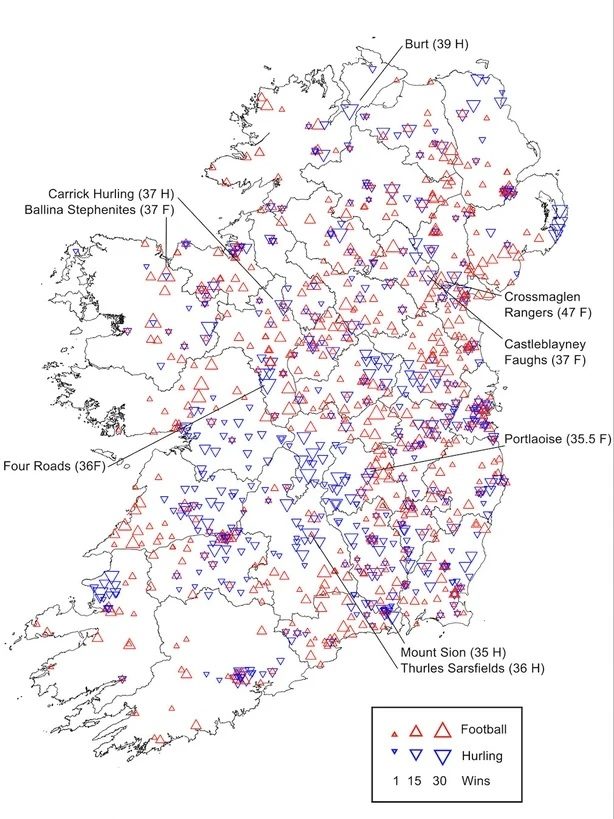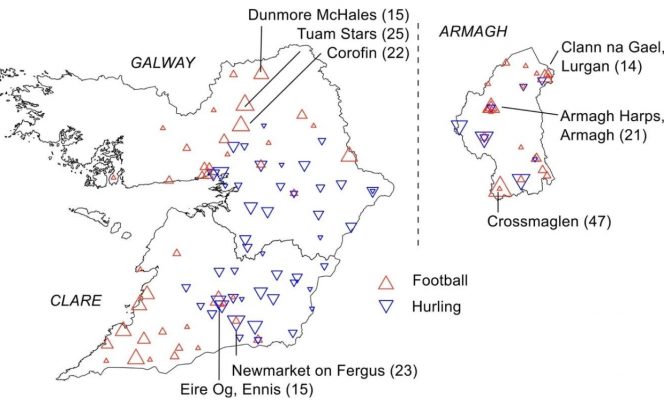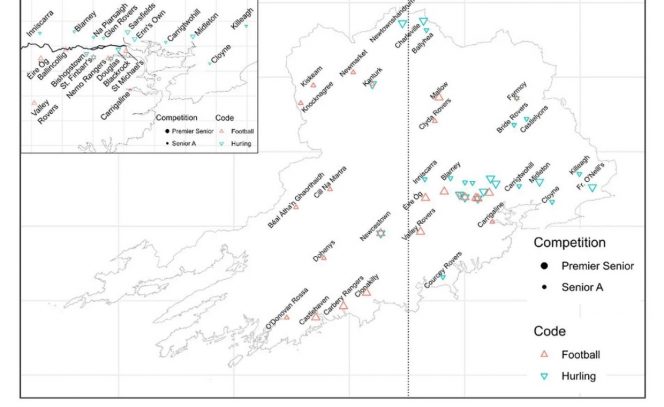Where are the hurling and football strongholds in Ireland?
ToggleExamining the number of county final wins for every club can show the strengths of hurling and football throughout the country, write Dr Gerard McCarthy and research assistants Hannah Shen and Amelia Carroll of the Geography Department.
The All-Ireland hurling final took place last weekend, an epic contest that saw Clare beat Cork by a single point. The football final is due to take place this Sunday in Croke Park in Dublin. As the attention of the nation focuses on the counties of Galway and Armagh, we're taking a step back to look at the wider geography of the GAA.
Strength in football or hurling is often associated with county success at the highest level such as Kerry and Dublin in football and Kilkenny, Cork (if you've a good memory), Tipperary and, more recently, Limerick in hurling.
But these narrow geographical brushes do not paint the full picture of the rich geography of the GAA in Ireland. Even within these counties, there are strongholds for each code: hurling is the game of choice in the corner of Kerry north of Tralee and there are football strongholds along south Tipperary stretching through Clonmel and Carrick-on-Suir.

We have looked at the number of senior county wins for every club in both football and hurling (the "roll of honour") to show the strengths of both GAA codes throughout the country. The club roll of honour is a staple of matchday programmes at county finals and provides us with a dataset of hurling and football throughout the country stretching as far back as the late 1880s.
The location of current clubs is available via the work of Ryan McGuinness at GAA Pitch Finder and we can cross reference these locations with the roll of honour. This of course does not apply to every winning club, however, as many clubs have become defunct, merged with another or changed names over the years. With over 1,100 clubs on our full list and many mysterious former clubs, this was quite a challenge.
GAA clubs are found in every corner of Ireland that is not predominantly mountain, lake, or unionist. Fittingly, as Armagh are gearing up for their first final in 21 years, the leading club in the all-time roll of honour is the mighty Crossmaglen Rangers (47 wins). The dominance of Crossmaglen has made them a mighty oak tree (or should that be apple tree) that little grows around, meaning the distribution of football wins in Armagh is very localised.
In contrast to the six-time All-Ireland club winning Cross, the next two clubs on the list are hurling teams hailing from Donegal and Leitrim: as the late, great Micheál Ó Muircheartaigh might say: neither a hurling stronghold. Burt, on the road from Letterkenny to Derry, have won 39 Donegal hurling titles including an impressive run from 1991 to 2006 of 16 titles in a row.
Carrick Hurling compete in the Leitrim Senior Hurling championship or, as it currently is, the Leitrim Senior Hurling final, with only two teams competing, and have won 37 hurling titles. Ballina Stevenites (Mayo) and Castleblaney Faughs (Monaghan) also both have 37 football titles each. Four Roads Hurling in Roscommon are next with 36 titles, hailing from the region around Roscommon town in the south of a footballing county where hurling rules.
Rounding out the top 10, between the hurling clubs of Thurles Sarsfields (Tipperary, 36 wins) and Mount Sion (Waterford, 35 wins) is Portlaoise with 35 and a half football wins in Laois. The half comes from a split win between Maryborough and The Heath in 1892, Portlaoise being known as Maryborough in those days.
Our map reveals some details of the hurling regions of Ireland that are not shown in the 1993 article titled The Geography of Hurling, by Kevin Whelan or by looking at the hurling populations at a county level. The well known hurling region that encompasses southeast Galway, east Clare, southwest Offaly, west Laois, east Limerick, north Tipperary, and Kilkenny meets an end near the the Waterford border, with footballing strength in south Tipperary, mid-Waterford, and even south Kilkenny emerging.
Some isolated pockets of hurling strength exist in northwest Kerry, south of the Ards peninsula in Down and north (not just the Glens) of Antrim. Beyond these, a strong hurling region spans northeast Westmeath to southwest Meath. In Westmeath, with the exception of Castletown Geoghegan, senior hurling champions hail from northeast of Mullingar, and dominated by small populations with little hurling in the bigger towns of Athlone or Mullingar. In Meath, the championship is dominated by Kilmessan and Trim and clubs in the southwest of the county.
It is a measure of the rurality of the GAA that our mapping works at all. If GAA were a more urban sport, we would be left with a map of major population centres, which wouldn't be very interesting.

In terms of the All-Ireland finalists, Galway and Clare are successful examples of our approach. The hurling region of Clare is mainly east of Ennis, and Galway's corridor of footballing success through Corofin and Tuam stands out.
In Armagh, the map is not so effective. There isn’t a particular cluster of football in the county with clubs dotted all around the county with the hurling clubs based in the south of the county. Club football wins in Armagh, as mentioned, is dominated by Crossmaglen whereas many more clubs will be represented in the team that takes to the field in this year’s All-Ireland football final.

In Cork, senior club wins, particularly in hurling, are dominated by city clubs, rendering the county with the most GAA clubs in Ireland seem sparse. More insight to the geography of GAA in Cork can be found in the map of Cork senior clubs.
Christy Ring famously said that hurling should be encouraged in Cork by sticking a knife in every football east of Bandon. The dashed line in our Cork map shows the logic in this! Football is strong in West Cork and near the Kerry border. Hurling is strong in the city, particularly dominant north of the river Lee, in the east of the county and near the Limerick border.
Amid all the excitement around the All-Ireland finals, it is worth remembering the reach of the GAA throughout Ireland and beyond. With the new split season, the county championships end in July and the pivot to the club championship will bring interest to all corners of Ireland.
This piece originally appeared on RTÉ Brainstorm
